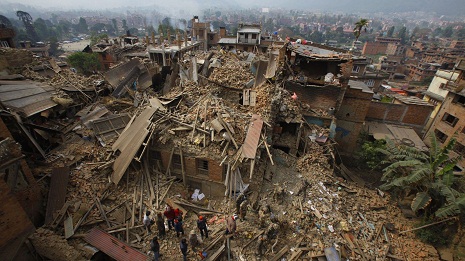Although the battered south Asian nation celebrated the rescue of two people pulled out alive from the wreckage of buildings in Kathmandu on Thursday, the sheer extent of the destruction is becoming clear.
Thousands of villages have been devastated, with up to 90% of clinics and schools in some districts rendered unusable.
Ram Sharan Mahat, the Nepalese finance minister, said it at least $2bn would be needed to rebuild homes, hospitals, government offices and historic buildings and he appealed for help from international donors.
“This is just an initial estimate and it will take time to assess the extent of damage and calculate the cost of rebuilding,” Mahat said.
Other estimates have been higher. Huge numbers of ancient monuments and important cultural buildings will also need to be restored, if they are not demolished. Major palaces in Kathmandu have been damaged and cracked.
Hundreds of thousands of people made homeless by the quake, which registered 7.8 magnitude, are yet to receive aid because of logistic bottlenecks, poor infrastructure and a chaotic government response.
Three thousand people are still unaccounted for in the badly hit Sindhupalchowk district, while little is known about northern areas of the Gorkha district where about 10,000 live. Local officials fear widespread destruction.
A local religious leader who had flown over the zone said people there were living in appalling conditions.
“There are still injured there who have not been treated. Whole villages are flattened. They need tents very badly,” Kempo Chimed Tsering said.
Kathmandu is slowly returning to normal with power supplies and communication networks restored to most of the city.
“I think it’s over now. I feel safe now,” said Vivek Ksimdung, 20, a student in the city.
However, many remain terrified of another tremor. Police have arrested two men for spreading rumours that a second major earthquake had been predicted. They will be charged with “inciting panic among the public”.
On Thursday night watching crowds cheered as Nepalese rescuers, assisted by a US disaster team, pulled a 15-year-old boy from the debris of a seven-storey structure, where he had reportedly stayed alive by eating jars of ghee and drinking water dripping from his clothes.
Just streets away, rescuers worked into the night to free a woman from the rubble of a hotel.
The dust-covered teenager, who had been trapped in a small gap behind a bike under two metres of rubble, was eventually lifted blinking into the sunlight and placed on a stretcher, with a blue brace around his neck and a drip in his arm.
“All of the sudden I saw light,” said the teenager, named variously in reports as Pemba Tamang and Pemba Lama, after he was extricated. He did not know whether he was alive or dead. “I thought I was hallucinating,” AP reported him as saying.
Libby Weiss, from an Israeli military-run medical centre, said he was doing well and did not appear to have any major injuries.
“I don’t have any logical explanation. It is miraculous. It is a wonderful thing to see in all this destruction,” she said.
“He was under the rubble for 120 hours and it is certainly the longest we have heard anybody of being under the rubble and surviving.
“We understand he didn’t have any food and just two jars of ghee, which he had at the time he was under the rubble.”
The second survivor was carried by stretcher to a waiting ambulance after Nepalese soldiers and a huge team of experts from France, Norway and Israel worked to rescue her.
“She was injured but she was conscious and talking,” a Nepalese army major said.
“She has been sent to a military hospital,” he said, identifying the woman to AFP as a kitchen worker in her mid-30s called Krishna Devi Khadka. “It is as though she had been born again.”
However, such stories remain rare after the “great quake”, as local media have called it.
Officials said Pemba had been talking to two other people trapped in the rubble until early Thursday, but they had gone silent. The body of a teenager was removed soon afterwards.
Emergency teams have mainly been pulling bodies from the rubble, a task made all the more perilous by more than 70 aftershocks, the strongest measuring 6.9 magnitude, the Indian meteorological department in Delhi said.
Rain has left many people with the dilemma of risking a return to damaged homes which could collapse in an aftershock or sleeping in tents or other temporary shelters.
Large numbers have left Kathmandu on free buses provided by the government, often to check on relatives in other regions.
The weather has cleared over much of the country, allowing rescue and relief missions to be stepped up. Much of the famous Khumbu valley, around Everest, had been cut off by bad weather for several days. Flights have now resumed.
The British and Chinese governments have said they are sending additional helicopters, and on Thursday, a group of Gurkhas serving in the British army arrived in the capital to lend a hand with the recovery. The soldiers from the Queen’s Gurkha Engineers Unit set up a portable water purification unit on the grounds of what used to a royal palace in Kathmandu.
Anger over the slow pace of the rescue flared earlier in the week with protests outside parliament.
The official death toll does not include the 19 people killed at Mount Everest – five foreign climbers and 14 Nepalese sherpas – when the quake caused an avalanche at base camp on the world’s highest peak.
The UN has launched an appeal for $415m (£270m) and Nepal is appealing to foreign governments for more helicopters.
There are widespread fears of disease in remote areas and in Kathmandu. One pharmacist in the Lalitpur area of Kathmandu immediately sold his entire stock of anti-diahorrhea medicine and oral rehydration salts.
More about:
















































